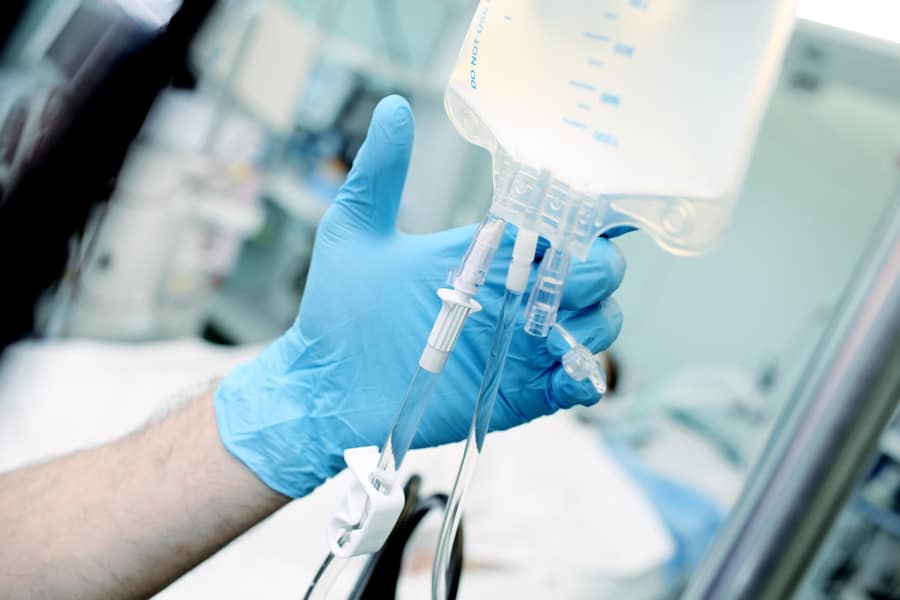Strengthening the case for goal directed fluid therapy
Intravenous (IV) fluids – or drips – are ubiquitous in hospitals and often used to treat dehydration, infection, cancer and pain. They’re also used during surgery to maintain hydration, blood pressure and blood flow. This not only ensures a patient’s tissues get enough blood, water, electrolytes and oxygen while they’re under the knife, but has also been shown to affect postoperative recovery – particularly following major abdominal surgery. Given enough fluids, patients can have a better chance at recovering faster without any complications. Too much or too little and the patient can suffer organ dysfunction, delayed gut function recovery and increased risk of complications after surgery.
Yet, achieving optimal fluid management can be challenging – particularly using parameters such as heart rate, blood pressure, central venous pressure or urine output – which poorly estimate how much fluid is reaching the heart and how much it will pump out.

One solution is ‘Goal Directed Fluid Therapy’ (GDFT). Here, medical practitioners administer fluid based on a predetermined goal, such as stroke volume – the amount of blood a heart pumps out in one beat, stroke volume variation (SVV), cardiac output – the amount of blood pumped out in one minute, and oxygen delivery. SVV, as a percentage change of stroke volume during the ventilatory cycle, is calculated from its relationship with the maximum stroke volume, minimum stroke volume, and mean stroke volume over a 20-second time interval and expressed as follows:
SVV (%) =
(maximum stroke volume – minimum stroke volume) / mean stroke volume.
This practice has been steadily gaining popularity, but despite numerous studies, researchers still haven’t reached a consensus on which measurement is best or how effective GDFT really is.
To help determine the true value of SVV-based GDFT in abdominal surgery patients, Beijing Tongren Hospital Department of Anesthesiology Vice-Chief Anesthesiologist, Dr Yanxia Sun and her team are running a clinical trial, exploring participants’ responses to the treatment and their short and long term prognoses.

Taking a pulse on GDFT
Improving patient outcomes is a major goal of modern medicine and one that anaesthetists and researchers have been trying to achieve through fluid therapy for years. But conflicting study results have prevented researchers from identifying the best GDFT goals or monitoring devices for the job. Indeed, the effectiveness of GDFT has been inconclusive despite increasing clinical trials and meta-analyses.
Where some studies have shown GDFT to help improve survival rates, reduce complications and support gut function recovery in major abdominal surgery patients, larger, higher-quality studies have failed to replicate these beneficial effects.

Additionally, while stroke volume has been suggested as the “gold standard” measurement for GDFT around and throughout surgeries, studies have failed to show that it is any more useful than other goals such as cardiac output, cardiac index – which measures the amount of blood pumped around the body per minute, or oxygen delivery index.
Further, researchers haven’t nailed down the most appropriate type of monitoring device, with oesophageal doppler, calibrated pulse contour analyses and bioreactance-based non-invasive cardiac output monitors all being used and very little agreement between them.
… medical practitioners hope to tease out and standardise best practices for fluid management and enhance patient care.
Variation in surgical methods and study approaches, sizes and data quantity and quality have all contributed to the ambiguity around GDFT and prevented medical practitioners from optimising patient care.
As a result, researchers have questioned whether GDFT’s “routine” use is justifiable, given it can increase costs, lead to inappropriate patient care and has been shown to have minimal – if any – benefits when used as part of an ‘enhanced recovery after surgery’ (ERAS) programme. These programs are designed to improve patient outcomes, reduce healthcare costs and shorten recovery time by using minimally invasive surgeries such as laproscopies, avoiding overloading patients with fluids or using laxatives to empty their bowels before surgery, limiting the use of opioids in pain management and avoiding unnecessary drains and catheters, among other methods. Many of these elements can help minimise bodily stress and blood loss and maintain hydration, thus reducing fluid requirements and GDFT’s value during surgery.

However, other researchers argue that having fluid management goals – even if they’re not solidly backed – is still better than not having one at all, particularly when it comes to patients who are moderate- to high-risk, undergoing major surgeries or outside an ERAS programme. Here, the researchers cite studies that have shown GDFT to help shorten hospital stays, reduce complications and suggest that increased costs could be mitigated by working to minimise pulse pressure variation rather than use devices like a cardiac output monitor. They add that, since institutions have standardised pain management protocols despite not having the best possible evidence, that GDFT protocols should be too. In a letter to Anesthesia and Analgesia, Cannesson and Gan also pose a more emotionally charged question, asking readers whether they’d want conventional therapy or GDFT if they were having high-risk surgery tomorrow.

Either way, researchers and medical practitioners hope to tease out and standardise best practices for fluid management and enhance patient care. This is where Dr Sun and her team come in…
Stabilising GDFT
Knowing the contention around GDFT and having completed two meta-analyses on the topic herself, Dr Sun and her team designed a clinical trial to measure the effectiveness of SVV-guided GDFT. During the trial, 100 adult major abdominal surgery patients randomly received SVV-guided GDFT or conventional fluid therapy based on central venous pressure, average arterial pressure or urine output. Here, researchers recorded patients’ basic vital signs, operation time, mechanical ventilation time, type of fluid input, urine volume, blood loss volume and the amount of oxygen consumed versus oxygen delivered.
In the year following the surgeries, the researchers will be checking in with the patients and recording whether there were any postoperative deaths or complications, hospital stay durations, quality of recovery and comfort.

The researchers hope this trial – set to be completed in August 2020 – will provide a clearer picture of SVV-guided GDFT’s effect on long term prognoses in patients undergoing abdominal surgery and support its use in clinical settings.
…Dr Sun and her team hope to help strengthen the case for clinical use of SVV-guided GDFT…
Improving patient care
Optimising patient care is a driving force in modern medicine and fluid therapy is part of that. Getting it right can help patients recover faster, spend less time in hospital and avoid complications during or after surgery, but getting it wrong can expose them to increased risk of complications, organ dysfunction, longer recovery times and hospital stays and higher costs. Therefore, it’s critical for researchers to isolate and standardise effective fluid management methods.
Conventionally, medical practitioners have administered fluid based on parameters such as heart rate, blood pressure, central venous pressure or urine output, but these fail to adequately estimate how much fluid is reaching or being pumped out of the heart – making it difficult to maintain patients’ hydration, blood pressure and blood flow.

GDFT has been offered as a solution, however, even with mounting studies, researchers have struggled to confirm its effectiveness and which parameters and machinery are best for the job. As a result, researchers are calling for more, higher-quality studies to help determine whether GDFT really is beneficial to patients and under which circumstances. Ideally, they hope to determine best practices for fluid therapy and standardise them to enhance patient care.
Through their clinical trial, Dr Sun and her team hope to help strengthen the case for clinical use of SVV-guided GDFT and avoid the pitfalls of previous studies. With any luck, by August next year, the group will have the data and means to do just that and bring researchers and medical practitioners one step closer to optimising fluid therapy.
Personal Response
What have you learned from other studies that have helped you strengthen the value of this trial, compared to others?
<> Stroke volume variation (SVV)-GDFT, is attracting increasing attention as a reliable, less invasive and easy to use strategy for protocolised fluid management. There have been increasing published studies evaluating the effect of SVV-GDFT on postoperative recovery after major surgery, However, the evidence for the beneficial effects of GDHT for postoperative recovery after abdominal surgery remains inconsistent. Furthermore, the optimal SVV cut-off value for evaluating fluid responsiveness was not clear, therefore we have performed this large-size study to evaluate the efficacy and safety of SVV-GDFT on postoperative recovery. We also aim to identify the cut-off SVV value for perioperative fluid therapy for major abdominal surgery.
With so much confusion about which parameters are most helpful, why did you choose to measure SVV?
<> It has been suggested that intraoperative fluid administration may be better guided by flow related parameters. Stroke volume variation (SVV) is an accurate parameter which is influenced by cardiopulmonary interactions in patients under general anaesthesia receiving mechanical ventilation, can accurately predict whether a patient is likely to be responsive or nonresponsive to volume expansion and indicates whether the patient is on the steep portion or on the plateau of the Franck Starling relationship. Consequently, the concept of cardiac output maximisation could be achieved using SVV minimisation. Therefore, we chose this parameter to guide our GDFT protocols.
